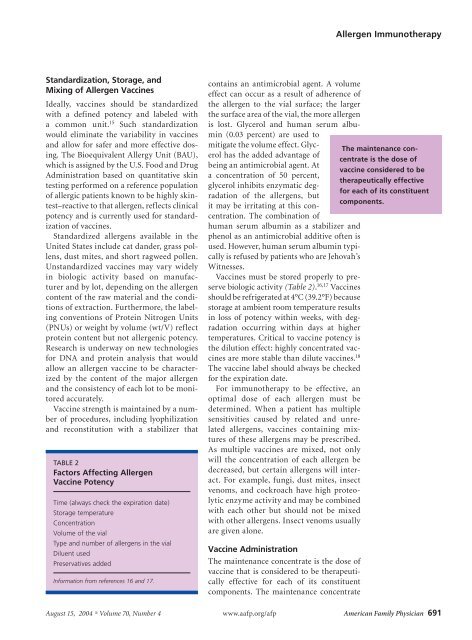Immunotherapy Safety for the Primary Care ... - U.S. Coast Guard
Immunotherapy Safety for the Primary Care ... - U.S. Coast Guard
Immunotherapy Safety for the Primary Care ... - U.S. Coast Guard
You also want an ePaper? Increase the reach of your titles
YUMPU automatically turns print PDFs into web optimized ePapers that Google loves.
Allergen <strong>Immuno<strong>the</strong>rapy</strong><br />
Standardization, Storage, and<br />
Mixing of Allergen Vaccines<br />
Ideally, vaccines should be standardized<br />
with a defined potency and labeled with<br />
a common unit. 15 Such standardization<br />
would eliminate <strong>the</strong> variability in vaccines<br />
and allow <strong>for</strong> safer and more effective dosing.<br />
The Bioequivalent Allergy Unit (BAU),<br />
which is assigned by <strong>the</strong> U.S. Food and Drug<br />
Administration based on quantitative skin<br />
testing per<strong>for</strong>med on a reference population<br />
of allergic patients known to be highly skintest–reactive<br />
to that allergen, reflects clinical<br />
potency and is currently used <strong>for</strong> standardization<br />
of vaccines.<br />
Standardized allergens available in <strong>the</strong><br />
United States include cat dander, grass pollens,<br />
dust mites, and short ragweed pollen.<br />
Unstandardized vaccines may vary widely<br />
in biologic activity based on manufacturer<br />
and by lot, depending on <strong>the</strong> allergen<br />
content of <strong>the</strong> raw material and <strong>the</strong> conditions<br />
of extraction. Fur<strong>the</strong>rmore, <strong>the</strong> labeling<br />
conventions of Protein Nitrogen Units<br />
(PNUs) or weight by volume (wt/V) reflect<br />
protein content but not allergenic potency.<br />
Research is underway on new technologies<br />
<strong>for</strong> DNA and protein analysis that would<br />
allow an allergen vaccine to be characterized<br />
by <strong>the</strong> content of <strong>the</strong> major allergen<br />
and <strong>the</strong> consistency of each lot to be monitored<br />
accurately.<br />
Vaccine strength is maintained by a number<br />
of procedures, including lyophilization<br />
and reconstitution with a stabilizer that<br />
TABLE 2<br />
Factors Affecting Allergen<br />
Vaccine Potency<br />
Time (always check <strong>the</strong> expiration date)<br />
Storage temperature<br />
Concentration<br />
Volume of <strong>the</strong> vial<br />
Type and number of allergens in <strong>the</strong> vial<br />
Diluent used<br />
Preservatives added<br />
In<strong>for</strong>mation from references 16 and 17.<br />
contains an antimicrobial agent. A volume<br />
effect can occur as a result of adherence of<br />
<strong>the</strong> allergen to <strong>the</strong> vial surface; <strong>the</strong> larger<br />
<strong>the</strong> surface area of <strong>the</strong> vial, <strong>the</strong> more allergen<br />
is lost. Glycerol and human serum albumin<br />
(0.03 percent) are used to<br />
mitigate <strong>the</strong> volume effect. Glycerol<br />
has <strong>the</strong> added advantage of<br />
The maintenance concentrate<br />
is <strong>the</strong> dose of<br />
being an antimicrobial agent. At<br />
vaccine considered to be<br />
a concentration of 50 percent,<br />
<strong>the</strong>rapeutically effective<br />
glycerol inhibits enzymatic degradation<br />
of <strong>the</strong> allergens, but<br />
<strong>for</strong> each of its constituent<br />
components.<br />
it may be irritating at this concentration.<br />
The combination of<br />
human serum albumin as a stabilizer and<br />
phenol as an antimicrobial additive often is<br />
used. However, human serum albumin typically<br />
is refused by patients who are Jehovah’s<br />
Witnesses.<br />
Vaccines must be stored properly to preserve<br />
biologic activity (Table 2). 16,17 Vaccines<br />
should be refrigerated at 4°C (39.2°F) because<br />
storage at ambient room temperature results<br />
in loss of potency within weeks, with degradation<br />
occurring within days at higher<br />
temperatures. Critical to vaccine potency is<br />
<strong>the</strong> dilution effect: highly concentrated vaccines<br />
are more stable than dilute vaccines. 18<br />
The vaccine label should always be checked<br />
<strong>for</strong> <strong>the</strong> expiration date.<br />
For immuno<strong>the</strong>rapy to be effective, an<br />
optimal dose of each allergen must be<br />
determined. When a patient has multiple<br />
sensitivities caused by related and unrelated<br />
allergens, vaccines containing mixtures<br />
of <strong>the</strong>se allergens may be prescribed.<br />
As multiple vaccines are mixed, not only<br />
will <strong>the</strong> concentration of each allergen be<br />
decreased, but certain allergens will interact.<br />
For example, fungi, dust mites, insect<br />
venoms, and cockroach have high proteolytic<br />
enzyme activity and may be combined<br />
with each o<strong>the</strong>r but should not be mixed<br />
with o<strong>the</strong>r allergens. Insect venoms usually<br />
are given alone.<br />
Vaccine Administration<br />
The maintenance concentrate is <strong>the</strong> dose of<br />
vaccine that is considered to be <strong>the</strong>rapeutically<br />
effective <strong>for</strong> each of its constituent<br />
components. The maintenance concentrate<br />
August 15, 2004 Volume 70, Number 4 www.aafp.org/afp American Family Physician 691
















